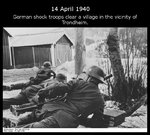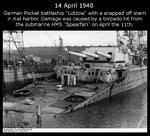- Thread starter
- #661
Njaco
The Pop-Tart Whisperer
April 12 Friday
NORTHERN EUROPE: German forces are pushing out from Oslo in all directions. They take Kongsberg to the southwest of the capital.
The British begin sending bombers to attack Luftwaffe bases in Norway. At 1200 hours, 23 Blenheim bombers, 36 Wellington bombers, and 24 Hampden bombers take off from airfields in Britain to attack German ships off Kristiansand. Only one finds a target, and is unsuccessful in bombing it. Intercepted by Bf 109s from JG 77, one Hampden is shot down by Lt. Edgar Struckmann, his first kill. A second British raid on the airfield begins at 1300 hours. Bf 109's of II./JG 77 engage the twelve Hampden bombers from RAF Nos. 44 and 50 Squadrons, shooting down eight British bombers at a cost of five Bf 109's with four pilots killed. Victory claims from the 5 Staffel include Fw. Robert Menge for his first, Ofw. Edgar Herfeld for his first and a second victory for Uffz. Kurt Opolski. Victors from the 6 Staffel include Fw. Ertel for his first score, Ofw. Hermann Stierle for his first kill, and a first for Oblt. Wilhelm Ruthammer. Pilots getting their second victories include Lt. Dietrich Bösler of Stab II./JG 77 and Hptm. Franz-Heinz Lange of 6./JG 77. Ten minutes after this action a rotte of fighters from the Gruppe shoot down a Coastal Command Hudson of RAF No 233 Squadron.
A formation of nine British planes attacks the harbour at Narvik without success. One of the bombers is shot down by anti-aircraft fire. Over Oslo the Luftwaffe attacks the facilities at Gardomoen. Several hits are recorded on some buildings and the harbor at Frederikstad.
Around 1700 hours a formation of British Wellington bombers attacks the airfield at Stavanger. Intercepted by aircraft from the Zerstörer unit of KG 30 and ZG 76, five Wellingtons are claimed shot down by the defending fighters. Only one bomber is given credit for being destroying and it's given to an anti-aircraft battery at Stavanger, not the pilots.
Norwegian artillery Major Hans Holtermann and 250 volunteers began reactivating the old fort at Ingstadkleiva near Trondheim, Norway, which would become known as Hegra Fortress for defense against the Germans. The fort has mothballed artillery (four 10.5 cm and two 7.5 cm in half-turrets and 4 Krupp m/1887 field guns) and plenty of ammunition. A German Major requests the fort's surrender but Holtermann refuses.
German battleships "Gneisenau", "Scharnhorst" and "Admiral Hipper" are located by air reconnaissance southwest of Stavanger on their way home. Attacks by British land-based and carrier aircraft fail. Despite this escape the German navy has lost heavily in the campaign so far.
GERMANY: Luftwaffe chief Hermann Göring forms Luftflotte 5, under his second in command Generaloberst Erhard Milch in Hamburg, to coordinate an expanding role in Norway. Luftwaffe duties include air defenses, airlifts and offensive strikes against Norwegian defenders and the Royal Navy. Milch would soon establish his headquarters in Oslo, Norway.
MEDITERRANEAN: The British Cyprus Regiment was established from volunteers from the Greek and Turkish communities of Cyprus.
ATLANTIC OCEAN: German submarine U-37 sank British ship "Stancliffe" with one torpedo 45 miles northeast of the Shetland Islands, Scotland, United Kingdom at 0942 hours, killing 21. 16 survivors in one lifeboat would later make a landing at nearby Unst Island.
WESTERN FRONT: Two Royal Navy destroyers, including HMS "Suffolk", arrived at the Faroe Islands and negotiations began concerning a formal, peaceful occupation by British troops.
.

NORTHERN EUROPE: German forces are pushing out from Oslo in all directions. They take Kongsberg to the southwest of the capital.
The British begin sending bombers to attack Luftwaffe bases in Norway. At 1200 hours, 23 Blenheim bombers, 36 Wellington bombers, and 24 Hampden bombers take off from airfields in Britain to attack German ships off Kristiansand. Only one finds a target, and is unsuccessful in bombing it. Intercepted by Bf 109s from JG 77, one Hampden is shot down by Lt. Edgar Struckmann, his first kill. A second British raid on the airfield begins at 1300 hours. Bf 109's of II./JG 77 engage the twelve Hampden bombers from RAF Nos. 44 and 50 Squadrons, shooting down eight British bombers at a cost of five Bf 109's with four pilots killed. Victory claims from the 5 Staffel include Fw. Robert Menge for his first, Ofw. Edgar Herfeld for his first and a second victory for Uffz. Kurt Opolski. Victors from the 6 Staffel include Fw. Ertel for his first score, Ofw. Hermann Stierle for his first kill, and a first for Oblt. Wilhelm Ruthammer. Pilots getting their second victories include Lt. Dietrich Bösler of Stab II./JG 77 and Hptm. Franz-Heinz Lange of 6./JG 77. Ten minutes after this action a rotte of fighters from the Gruppe shoot down a Coastal Command Hudson of RAF No 233 Squadron.
A formation of nine British planes attacks the harbour at Narvik without success. One of the bombers is shot down by anti-aircraft fire. Over Oslo the Luftwaffe attacks the facilities at Gardomoen. Several hits are recorded on some buildings and the harbor at Frederikstad.
Around 1700 hours a formation of British Wellington bombers attacks the airfield at Stavanger. Intercepted by aircraft from the Zerstörer unit of KG 30 and ZG 76, five Wellingtons are claimed shot down by the defending fighters. Only one bomber is given credit for being destroying and it's given to an anti-aircraft battery at Stavanger, not the pilots.
Norwegian artillery Major Hans Holtermann and 250 volunteers began reactivating the old fort at Ingstadkleiva near Trondheim, Norway, which would become known as Hegra Fortress for defense against the Germans. The fort has mothballed artillery (four 10.5 cm and two 7.5 cm in half-turrets and 4 Krupp m/1887 field guns) and plenty of ammunition. A German Major requests the fort's surrender but Holtermann refuses.
German battleships "Gneisenau", "Scharnhorst" and "Admiral Hipper" are located by air reconnaissance southwest of Stavanger on their way home. Attacks by British land-based and carrier aircraft fail. Despite this escape the German navy has lost heavily in the campaign so far.
GERMANY: Luftwaffe chief Hermann Göring forms Luftflotte 5, under his second in command Generaloberst Erhard Milch in Hamburg, to coordinate an expanding role in Norway. Luftwaffe duties include air defenses, airlifts and offensive strikes against Norwegian defenders and the Royal Navy. Milch would soon establish his headquarters in Oslo, Norway.
MEDITERRANEAN: The British Cyprus Regiment was established from volunteers from the Greek and Turkish communities of Cyprus.
ATLANTIC OCEAN: German submarine U-37 sank British ship "Stancliffe" with one torpedo 45 miles northeast of the Shetland Islands, Scotland, United Kingdom at 0942 hours, killing 21. 16 survivors in one lifeboat would later make a landing at nearby Unst Island.
WESTERN FRONT: Two Royal Navy destroyers, including HMS "Suffolk", arrived at the Faroe Islands and negotiations began concerning a formal, peaceful occupation by British troops.
.


